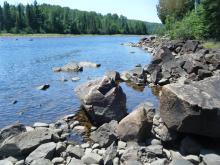Research
Research > Themes >
Theme 2: Modeling of Fish-Habitat Interactions in the Context of Hydropower

Hydropower developments transform natural rivers or lakes into regulated rivers and reservoirs. Although much emphasis has been put on the study of the effects of hydropower on rivers (see Theme 1), much less attention is often given to lakes and reservoirs. The general objective of Theme 2 of the research program of NSERC HydroNet is to develop protocols and models to better estimate the effects of the formation of a reservoir on metrics of the productive capacity of fish habitats and on processes that determine the survival of fish populations.
The formation of a reservoir modifies the original settings found in rivers and lakes, creates new environmental conditions, and generates distinctive ecological opportunities and challenges. These may be reflected in the loss or the appearance of specific types of habitats, the changes in the consequences of particular fish behaviour, and the modifications of the dynamics of ecosystems. Assessment of the potential effects of changes in the structure and dynamics ecosystems requires: 1) the development of standardized sampling methods and protocols to estimate metrics of the productive capacity of fish in an heterogeneous mosaic of habitat patches; and, 2) the study of the interactions between fish behaviour, ecological processes, and altered ecosystem dynamics.
Key objectives:
- to develop standardized sampling methods and protocols to estimate and eventually predict metrics of the productive capacity of fish in lakes and reservoirs;
- to propose systematic frameworks for assessing entrainment risk and designing options to protect fish.
The research program is organized around two components:
